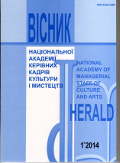FR. SCHLEGEL: CULTURAL ASPECT OF SYMBOLISM IN THE VISUAL ARTS
DOI:
https://doi.org/10.32461/2226-3209.1.2014.137884Keywords:
symbol, symbolism, allegory, classical, romantic, national, story, traditionAbstract
Actuality of consideration consists in finding main characteristic of determination idea "symbolism" in the fine art in conception of Fr. Shlegelya in the context of determination his cultural sence from positions of modern researches. Stage of scientific study of the problem: working and analysis of idea "symbolism" in the context of conception of Fr. Shlegelya enganged S. S. Averincev, V. V. Bichkov, M. Lifshic, O. F. Losev, S. Sicheva, Y. Popov and others. Purpose of the article: through the prism of critical analysis explore the basic ideas of Fr. Shlegelya regarding the concept of symbolism in a fine art, which expounded in his labours from different periods.
Frederic Shlegel is one of the leaders Jena's romantics – in his aesthetically cultural reasonings, which are on fundamentally based on the principle of fragmentation, went out from the dominating time of the ancient culture's rise and comparing it with modern culture. Shlegel, in contradistinction to radical statements of Goethe, who believes that "classic – a healthy, romantic sick", doesn't resort to radical conviction of modern, romantic, and sees in it the potential source of futher historical development of culture. Not coincidentally in his essays "Description pictures from Paris and Netherlands" he marks that "culture in each her part can only join the part, which has already created" [4, 238], thus underlining irreversibility of interconnection and interconditionality of different cultural and historical periods of human development.
At the same time formation and development of culture in general and philosophy, in particular, is unfolding between the ideal and the real oppositions, which are also used by Schelling in "Philosophy of art", that are correlated in Schlegel with mind and universum. Like the ideas of Shelling, who argues about detection prototype, ideas – divine – in symbolic images of art, Schlegel determines the symbolic nature of art, which consists of ideas-symbols by which the human discovers the hidden contents of this world.
Giving main attention in the labours to research literary-poetic works, Schlegel also applies to the analysis of fine art, which examines in indissoluble unity with all other spheres of artistic activity. Thus poetry plays the role of the socalled universal universality, inherent in any other art, including fine arts, which should in its inner essence be poetic. In opinion of Schlegel, painting must contain the spirit and the letter, that – poetry. "The artist must be a poet, but a poet not in words, but in paints".
Turning to the analysis of painting works, Schlegel presents himself as a supporter of the "old painting", considers the last real painters Titian, Corregio, Andrea del Sarto, Giulio Romano and others. In futher it becomes the impetus for the formation of the new trends in fine art, directed to return the lost authenticity and primary cleanliness in painting, and leads to the brotherhood of "Nazareyci" and "Pre-Raphaelite", which rod principles are a return to the ideals of art period before Raphael.
Turning to the analysis of portrait genre, philosopher comes to the kind of symbolic understanding, marking that "Raphael and Leonardo – gave axample of a comletely another kind of portrait, which I would call a symbolic". In the opinion of Schlegel, they transferred not just an appearance of a person, they transferred its inner essence, the spirit, which becomes manifested symbollicaly in the face. Schlegel also classifies exactly historical painting to the category of symbolic, marking that there is no other genres except historical, except for historical. In his deep persuasion, an artist who fully realized calling, aims symbolic disclose the secrets of divine meanings in their writtings, so everything else becomes secondary and auxiliary.
Schlegel's appeal to the national roots of culture and art is presented as an important point in his considerations. In the deep conviction of philosopher, "painting must be absolutely individual, and, therefore, the national".
Thus he pays attantion to national variety of European culture, which consists of the large number of original, unique and individually painted cultures.
Downloads
Published
Issue
Section
License
Authors who publish with this journal agree to the following terms:
1. Authors retain copyright and grant the journal right of first publication with the work simultaneously licensed under a Creative Commons Attribution License International CC-BY that allows others to share the work with an acknowledgement of the work's authorship and initial publication in this journal.
2. Authors are able to enter into separate, additional contractual arrangements for the non-exclusive distribution of the journal's published version of the work (e.g., post it to an institutional repository or publish it in a book), with an acknowledgement of its initial publication in this journal.
3. Authors are permitted and encouraged to post their work online (e.g., in institutional repositories or on their website) prior to and during the submission process, as it can lead to productive exchanges, as well as earlier and greater citation of published work (See The Effect of Open Access).


